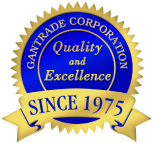Epoxies are a broad family of extremely versatile polymers. Used in coatings, adhesives, composites, and for encapsulation, they protect, join and extend the life of many everyday and industrial products, materials, and objects.
Gantrade is a leader in industrial epoxy resin, supplying manufacturers worldwide with an extensive range of epoxies and curing agents. We’re ready to meet all your epoxy needs.
What Are Industrial Epoxy Resins?
Epoxy resins are a form of thermosetting polymer. Generally starting out as a clear liquid, adding a curing agent or hardener initiates a crosslinking reaction. This locks the epoxy into a tough and durable three-dimensional structure.
Epoxy resins have properties that make them invaluable in myriad applications. These properties include:
- Resistance to high temperatures
- High strength
- Excellent chemical and water resistance
- Good adhesion to multiple surfaces
- Electrically insulating
- Toughness and durability
- Low shrinkage during curing
There are many different formulations of industrial epoxy resin, but just four categories account for the majority of volume sold. These are:
- Bisphenol A diglycidyl ethers (often referred to as BADGEs) – the workhorse grades, available in low, medium, and high viscosity grades and varying molecular weight
- Bisphenol F diglycidyl ethers (BFDGEs) – similar to BADGE but with lower viscosities and increased chemical resistance
- Epoxy novolac resins (sometimes written as “novolak”) - offer excellent hardness and heat, fire, and chemical resistance
- Aliphatic epoxy resins – a family of resins with differing properties, all feature low viscosity, UV weathering resistance, and transparency
Most epoxies need a hardener to initiate cross-linking. Many types are available, the main ones being: aromatic amines, aliphatic amines, cycloalipathic amines, and anhydrides.
What Are Industrial Epoxy Resins Used For?
The primary reasons for using an industrial epoxy resin are: to add hardness, durability, and weather resistance, to bond materials, and to provide protection and electrical insulation. This leads to their use in:
- Paint and coatings
- Adhesives
- Composites
- Electrical/electronic components and devices
In paints and varnishes, epoxy resin provides a clear, protective surface while adding toughness and a degree of flexibility. It shields pigments from UV light and protects the underlying surface from attack by chemicals or water.
Adhesives
Epoxies have low surface energy, which lets them form strong bonds with most other materials. (PTFE is one of the few materials epoxy will not bond to.) As adhesives, epoxies have the advantage of not needing air, moisture, or heat to form a bond.
Adhesives utilizing epoxy resins are used in many different industries where high-strength bonds are an alternative to fasteners or welding. Construction is a big market, along with the automotive and aerospace sectors.
Composites
Crosslinking during curing and excellent adhesive properties make industrial epoxies extremely useful in composite manufacturing. A wide variety of composite products are manufactured with the help of epoxies, up to and including structures as large as boats and wind turbine blades. On a smaller scale, although in very high volume, epoxies are a key component of the FR-4 material used to make circuit boards.
Electrical/Electronic Components
The primary use of industrial epoxy resin in the electronics sector is for printed circuit board (PCB) manufacture. The FR-4 substrate material used in most boards is composed of epoxy-impregnated fiberglass and is subsequently finished with an epoxy coating. Epoxies provide electrical insulating properties, along with strength, heat, and chemical resistance.
Another big application of epoxy resins in electronics manufacturing is in potting compounds used for encapsulation. These fill cavities and protect components from moisture and damage, with epoxies providing strength, chemical and moisture resistance, electrical insulating properties, and, when needed, transparency/clarity.
Benefits of Using Gantrade Epoxy Resin
Gantrade takes pride in serving diverse markets with consistent, high-quality epoxy resins. This is achieved through rigorous adherence to formal quality management systems (with ISO 9001 accreditation) and close attention to detail in every aspect of our operations. An extensive product portfolio and deep expertise enable us to give our customers the best materials for their particular application.
How Gantrade Serves The Industrial Epoxy Resin Market
Our global reach lets us serve customers in Europe, Asia, and the Americas. Our technical specialists work with customers to understand their needs and determine optimal solutions. An extensive range of products, all manufactured to extremely high standards, give us the ability to deliver precisely the properties and performance required.
Gantrade’s Industrial Epoxy Resin Products
Gantrade produces a wide range of epoxy materials and can supply suitable hardeners in every case. Industrial epoxies are just part of what we can offer, though. Our portfolio extends to plastics and resins, vinyl and acrylic monomers, diols and polyols, and much more.
Superior Products for Enhanced Performance
If you use industrial epoxy resin in your products, we may be able to help improve quality, consistency, and performance. Contact us, and let’s work together to find the industrial epoxy resins best for your needs.
Industrial Epoxy Resins - FAQs
The combination of high-performance capabilities and good processing characteristics has led to the use of epoxy resins in a broad array of applications, including coatings, adhesives, matrix resins for composites and circuit boards, encapsulation, and aircraft/aerospace components, to name a few. Epoxy resins are a highly versatile class of multifunctional reactive intermediates that are crosslinked into three-dimensional networks with curing agents or “hardeners.” When cured, the resulting thermoset material is formed without the generation of volatile by-products, resulting in void-free cured parts.
There are many types of epoxy resin intermediates. Commercially, the glycidyl ether epoxy resins dominates, and accounts for over 90% of the market.
Major performance attributes of epoxy resins include outstanding high-temperature properties, high strength, excellent chemical and water resistance, good adhesion to multiple surfaces, toughness, and durability. The many options for processing epoxy resins allows utilization in a myriad of applications.
What are the major types of epoxy resins?
The workhorse epoxy resins are the bisphenol A diglycidyl ethers (BADGEs), offered in both liquid and solid forms; Liquid forms represent about 65% of the volume of BADGE consumption. They are available in low, medium, and high viscosity grades, varying in MW. BADGE represents approximately 67% of the total epoxy volumes.

Bisphenol F resins have most of the attributes of BADGE but offer lower viscosities, better processing characteristics based on the lower viscosities, and better chemical resistance. Bisphenol F resins are used in chemical-resistant coatings, adhesives, composites, and electrical/electronic applications.
Epoxy novolac resins offer excellent heat, fire and chemical resistance, and hardness. This category includes phenol-novolac resins, o-cresol-novolac resins, and bisphenol A-novolac epoxy resins. They have multi-functional backbone structures. Major applications take advantage of the heat, fire, and chemical resistance, such as the automotive sector, high-temperature composites, and adhesives.
The aliphatic epoxy resins category includes hydrogenated bisphenol A epoxy resins, cycloaliphatic epoxy resins and diglycidyl ethers of diols such as butanediol, hexanediol, etc. The latter category of diol epoxy resins are primarily employed as reactive diluents for viscosity reduction. The cycloaliphatic epoxy resins are a special class of non-glycidyl epoxy resins marketed by the Daicel Corporation. All aliphatic epoxy resins offer UV weathering resistance and transparency, and low viscosities. The cycloaliphatic epoxy resins have very low chloride contents and excellent electrical/electronic insulating properties.
What are the market shares for the classes of epoxy resins?
The total market size for epoxy resins is approximately 3,100,000 MT in 2022 with a CAGR of about 5.5%. An estimated distribution of global market shares by the epoxy resin type are shown in the chart below.

The epoxy resins above are available in 220 Kg. drums, 17.6 MT per FCL; 1 MT IBC totes, and 20 MT ISO Tanks, delivered heated.
What are the epoxy hardener categories?
The types of hardeners that can be used for epoxy resins include aromatic amines, aliphatic amines, cycloalipathic amines, novolacs, anhydrides, polyamides, polyamido-amines, and polymercaptans (thiols). An indication of the market shares for the various type of hardeners is provided below.
The Gantrade blog on Epoxy Resins provides additional details on the attributes of the various hardener types available.

How are epoxy resin and hardener ratios calculated?
The epoxy resin and the hardener or curing agent should be mixed and reacted at approximately equivalent (1:1) stochiometric levels with the epoxy resin to obtain optimum properties. Weight ratios are usually expressed in parts of hardener per 100 parts of resin. To calculate the required ratio of hardener to epoxy resin, first calculate the hardener equivalent weight.
The amount of amine hardener required is calculated by from the EEW (epoxy equivalent weight) of the epoxy resin(s) and the hardener equivalent. For amines hardeners, AEW is related to the number of active hydroxy atoms on the primary amine moieties. Standard diamine hardeners have functionalities of four (4).
Thereafter, apply the equation below to determine the weight of amine hardener to use with 100 parts of the reactive epoxy resin(s) component.

Adding too much of either resin or hardener will alter the cure time and chemical reaction, and the mixture will not properly cure.
What are the major markets for epoxy resins?
The major market segment for epoxy resins is paint and coating for heavy-duty service, representing approximately 40% of the end-use volume. This is followed by adhesives, composites (including wind turbine blades), electrical/electronics, and construction. The global epoxy resin market volume is estimated to be about 3,100,000 MTs in 2022, with a CAGR projected at 5.5% in the next five-year period. The chart below shows the breakdown of the epoxy resin market by application.

For more information on epoxy resins and critical selection criteria, please contact Gantrade today.
























